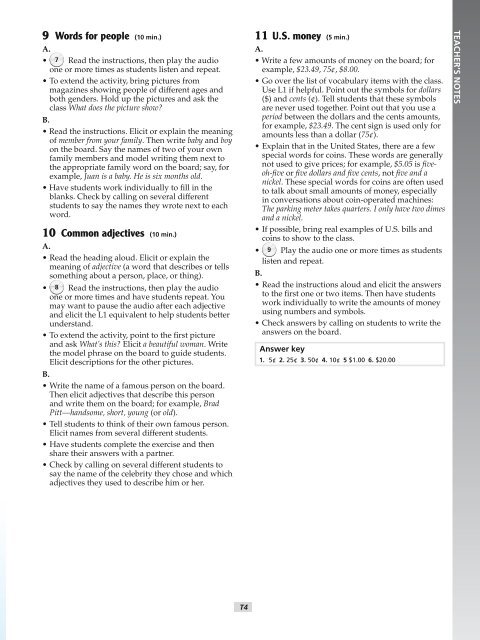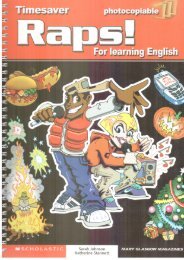English_Book_2-Teacher_300913
English_Book_2-Teacher_300913
English_Book_2-Teacher_300913
You also want an ePaper? Increase the reach of your titles
YUMPU automatically turns print PDFs into web optimized ePapers that Google loves.
9 Words for people (10 min.)A.• 7 Read the instructions, then play the audioone or more times as students listen and repeat.• To extend the activity, bring pictures frommagazines showing people of different ages andboth genders. Hold up the pictures and ask theclass What does the picture show?B.• Read the instructions. Elicit or explain the meaningof member from your family. Then write baby and boyon the board. Say the names of two of your ownfamily members and model writing them next tothe appropriate family word on the board; say, forexample, Juan is a baby. He is six months old.• Have students work individually to fill in theblanks. Check by calling on several differentstudents to say the names they wrote next to eachword.10 Common adjectives (10 min.)A.• Read the heading aloud. Elicit or explain themeaning of adjective (a word that describes or tellssomething about a person, place, or thing).• 8 Read the instructions, then play the audioone or more times and have students repeat. Youmay want to pause the audio after each adjectiveand elicit the L1 equivalent to help students betterunderstand.• To extend the activity, point to the first pictureand ask What’s this? Elicit a beautiful woman. Writethe model phrase on the board to guide students.Elicit descriptions for the other pictures.B.• Write the name of a famous person on the board.Then elicit adjectives that describe this personand write them on the board; for example, BradPitt—handsome, short, young (or old).• Tell students to think of their own famous person.Elicit names from several different students.• Have students complete the exercise and thenshare their answers with a partner.• Check by calling on several different students tosay the name of the celebrity they chose and whichadjectives they used to describe him or her.11 U.S. money (5 min.)A.• Write a few amounts of money on the board; forexample, $23.49, 75¢, $8.00.• Go over the list of vocabulary items with the class.Use L1 if helpful. Point out the symbols for dollars($) and cents (¢). Tell students that these symbolsare never used together. Point out that you use aperiod between the dollars and the cents amounts,for example, $23.49. The cent sign is used only foramounts less than a dollar (75¢).• Explain that in the United States, there are a fewspecial words for coins. These words are generallynot used to give prices; for example, $5.05 is fiveoh-fiveor five dollars and five cents, not five and anickel. These special words for coins are often usedto talk about small amounts of money, especiallyin conversations about coin-operated machines:The parking meter takes quarters. I only have two dimesand a nickel.• If possible, bring real examples of U.S. bills andcoins to show to the class.• 9 Play the audio one or more times as studentslisten and repeat.B.• Read the instructions aloud and elicit the answersto the first one or two items. Then have studentswork individually to write the amounts of moneyusing numbers and symbols.• Check answers by calling on students to write theanswers on the board.Answer key1. 5¢ 2. 25¢ 3. 50¢ 4. 10¢ 5 $1.00 6. $20.00TEACHER’S NOTEST4:20:37 PMPostcards_splitB_TE1_FM.indd T42/27/07 10:23:18 AM




